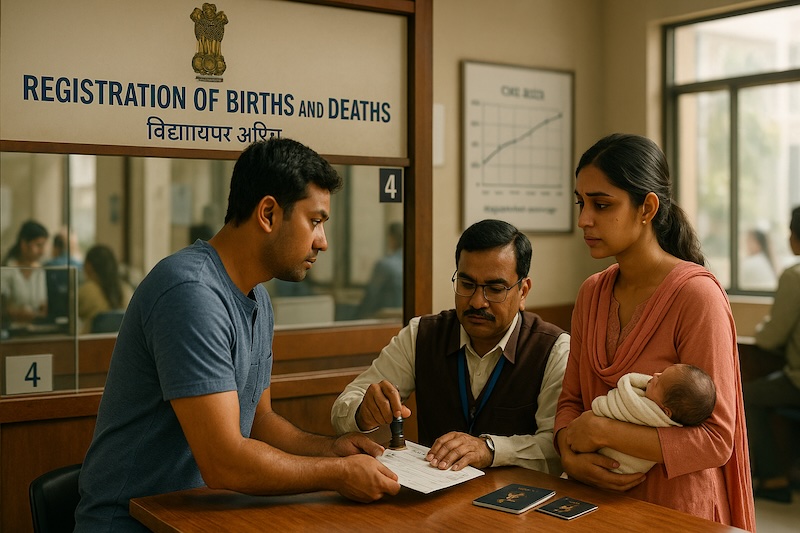CRS 2023: Record Births Abroad and Near-Complete Registration at Home

TL;DR: India’s Civil Registration System (CRS) records births and deaths for planning, monitoring, and research. In 2023, a total of 62,182 births and 10,531 deaths of Indian citizens abroad were registered; the highest births since 2009. Domestic registration levels reached 98.4% for births and 97.2% for deaths, narrowing the gap to 1.2%.
Context:
The recently published “Report on Vital Statistics of India based on the Civil Registration System (CRS) 2023” offers valuable insights into the registration of births and deaths across the country. This data serves as an important foundation for generating reliable local-level statistics that support micro-level planning, monitoring, and evaluation of various government schemes. Beyond administrative purposes, the information collected through the CRS plays a crucial role in medical research and in understanding sex ratios, mortality trends, and causes of death.
Who compiles this data?
In India, the registration of births and deaths is governed by the Registration of Births and Deaths (RBD) Act, 1969, administered by the Office of the Registrar General of India (ORGI) and implemented by individual States and Union Territories. Within each State, the Chief Registrar serves as the primary authority responsible for enforcing the provisions of the Act. Drawing on the annual reports submitted by the States and UTs, the ORGI compiles and publishes a comprehensive report each year titled “Vital Statistics of India based on the Civil Registration System”, which presents detailed data and analysis on the country’s birth and death registrations.
Where can I download clean & structured data on Births & Deaths in India?
Clean, structured, and ready-to-use dataset on births and deaths from the Civil Registration System (CRS) is available for download on Dataful. It provides insights on year, state, region, and gender-wise births and deaths registered, infant births, still births and so on.
Key Insights
Highest number of births registered of Indian Nationals abroad in 2023
Under the Citizenship Act, 1955, births and deaths of Indian citizens occurring abroad are registered by the respective Indian Missions or Consulates. As per Rule 5 of the Citizens (Registration at Indian Consulates) Rules, 1956, these consulates are legally required to submit annual returns of such registrations to the Office of the Registrar General of India (RGI). In 2023, a total of 196 Indian missions in 150 countries reported 62,182 births and 10,531 deaths of Indian nationals. The number of registered births marks the highest since 2009, while deaths represent the second-highest since 2020. A country-wise analysis shows that the United Arab Emirates (UAE) continues to lead in the number of registered births, followed by other Middle Eastern nations such as Kuwait, Saudi Arabia, and Oman, along with the United States and the United Kingdom.
Birth and Death Registrations near complete coverage
The level of registration, defined as the proportion of registered births or deaths compared to those estimated through the Sample Registration System (SRS), serves as a key indicator of how effectively States and Union Territories record vital events. In 2023, the birth registration level rose to 98.4%, up from 92.7% in 2019, marking a 5.7 percentage point increase over five years. Similarly, the death registration level climbed to 97.2% from 92.0% during the same period, an improvement of 5.2 percentage points. The gap between birth and death registration levels has continued to shrink, standing at just 1.2% in 2023.
Why does it matter?
Accurate and complete registration of births and deaths is fundamental to effective governance. These records form the backbone of demographic data used for planning health services, education, and social welfare programmes. Reliable vital statistics help governments track population trends, monitor maternal and child health outcomes, and identify emerging public health issues.
Key Numbers
- Registered Births and Deaths of Indian Nationals abroad
2009: Births – 8246; Deaths- 1222
2014: Births – 25189; Deaths- 4161
2019: Births – 46475; Deaths- 7428
2023: Births – 62182; Deaths- 10531
- Levels of registration at births and deaths
2011: Births – 82.3%; Deaths- 66.4%
2015: Births – 86.9%; Deaths- 75.3%
2019: Births – 92.7%; Deaths- 92%
2023: Births – 98.4%; Deaths- 97.2%